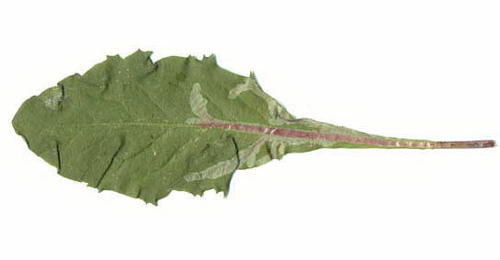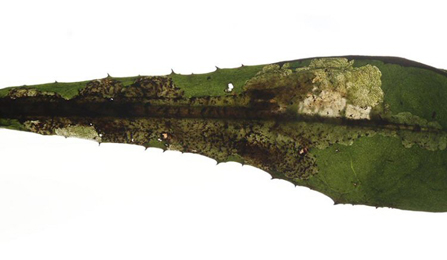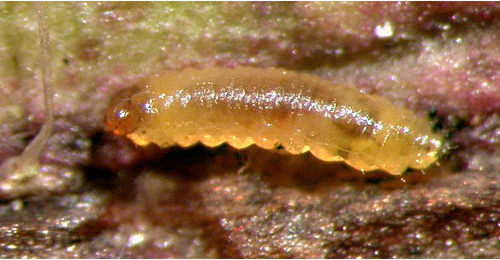|
||||||
|
HIERACIUM. Hawkweeds. [Asteraceae] |
|
More than two hundred and sixty species of Hieracium are recorded in Britain. Two hundred and forty-nine species are native. Weak-leaved Hawkweed (Hieracium attenuatifolium), Northroe Hawkweed (H. northroense) and Shetland Hawkweed (H. zetlandicum) are protected under Schedule 8 of the Wildlife and Countryside Act, 1981. Thirteen British miners are recorded on Hieracium. A key to the European miners recorded on Hieracium is provided in Bladmineerders van Europa. |
Key for the identification of the known mines of British |
||
Note: Diptera larvae may live in a corridor mine, a corridor-blotch mine, or a blotch mine, but never in a case, a rolled or folded leaf, a tentiform mine or sandwiched between two more or less circular leaf sections in later instars. Pupation never in a cocoon. All mining Diptera larvae are leg-less maggots without a head capsule (see examples). They never have thoracic or abdominal legs. They do not have chewing mouthparts, although they do have a characteristic cephalo-pharyngeal skeleton (see examples), usually visible internally through the body wall. The larvae lie on their sides within the mine and use their pick-like mouthparts to feed on plant tissue. In some corridor miners frass may lie in two rows on alternate sides of the mine. In order to vacate the mine the fully grown larva cuts an exit slit, which is usually semi-circular (see Liriomyza huidobrensis video). The pupa is formed within the hardened last larval skin or puparium and as a result sheaths enclosing head appendages, wings and legs are not visible externally (see examples). See Key to non-Diptera. |
||
1a >Stem-miner: A narrow, inconspicuous stem mine. Pupation at the end of the mine (Spencer, 1976: 64). Fine, upper- or lower-surface corridor, ending in a thick vein. From there the mine extends finally to the rind of the stem. There also the pupation takes place, usually not far from the root collar. Mines in the stem rind often are conspicuous through a red discoloration. |
||
|
||
Ophiomyia curvipalpis (Zetterstedt, 1848) [Diptera: Agromyzidae]. |
||
1b > Stem miner: An external stem mine with frass in two rows of disconnected strips. Pupation in stem at end of mine (Spencer, 1972b: 25; Spencer, 1976: 61 (fig. 63B), 65-6). |
||
|
||
Ophiomyia heringi Stary, 1930 [Diptera: Agromyzidae]. |
||
1c> Leaf miner: Mine primarily associated with mid-rib. |
||
1d > Leaf miner: Mine not primarily associated with mid-rib. |
||
2a > Leaf-miner: A distinctive mine primarily above mid-rib, with irregular short lateral offshoots into leaf blade. Pupation external (Spencer, 1972: 51 (fig. 172), 55; Spencer, 1976: 270, 271 (fig. 486)). Branched, whitish, upper-surface corridor; main axis overlying the midrib; side branches overlying the main lateral veins. (In Campanula and Phyteuma the mine is much less branched, sometimes nothing more than a corridor on top of the midrib). Frass in rather long strings. Usually the mines begins as a long and narrow, shallow, tortuous lower-surface corridor that ends upon the midrib but otherwise is not associated with the leaf venation. Often this initial corridor is filled with callus, and then even less conspicuous. Pupation outside the mine. A linear mine on the upper surface, usually following the midrib and showing side branches along the veins. The frass is in strings. |
||
|
||
|
||
Liriomyza strigata (Meigen, 1830) [Diptera: Agromyzidae]. |
||
2b > Leaf miner: A whitish blotch-mine along the mid-rib, with lateral offshoots into the leaf blade. Pupation at base of leaf in petiole (Spencer, 1972b: 25). Broad corridor overlying the midrib, with short excursion into the blade, mainly in its basal part. Frass concentrated in the basal part of the mine, corridors almost free from frass. Pupation in the mine, also in the basal part. |
||
 Mine of Ophiomyia pulicaria on Taraxacum officinale Image: © Willem Ellis (Bladmineerders van Europa) |
||
|
||
Ophiomyia pulicaria (Meigen, 1830) [Diptera: Agromyzidae]. |
||
2c > Leaf miner: Mine mainly in basal leaves, running along mid-rib, with short lateral offshoots into leaf blade (Spencer, 1972b: 71). Pupation takes place within the petiole or mid-rib (Spencer, 1976: 489). Upper-surface corridor in the leaf base, radiating from the base of the midrib. Frass in long strings along the sides of the mine. Primary feeding lines quite conspicuous. Pupation within the mine, in the leaf base or even deeper in the plant. |
||
|
||
Phytomyza rufescens von Roser, 1840 [Diptera: Agromyzidae]. |
||
3a > Leaf miner: Larva mining both lower and upper surface, unusually long, linear, conspicuously broad, frequently largely on the underside of the leaf. Pupation external (Spencer, 1972b: 76 (fig. 251); Spencer, 1976: 445 (fig. 780), 446). Corridor mine. The first part consists of a very long and narrow lower-surface corridor; the mine is quite shollow here, and often inconspicuous. The second part is upper-surface, uusally much shorter, and widens abruptly. Pupation outside the mine. |
||
|
||
Phytomyza marginellaFallén, 1823 [Diptera: Agromyzidae]. |
||
3b > Leaf-miner: Mine linear, whitish, both upper and lower surface. Pupation internal, at the end of the mine with the anterior spiracles projecting through the epidermis (Spencer, 1976: 433). Upper-surface, less often lower-surface corridor. Frass in isolated grains. Pupation within the mine, usually in a lower-surface puparial chamber. A long whitish upper surface corridor, which eventually goes lower surface. |
||
|
||
Chromatomyia
horticola (Goureau, 1851) [Diptera: Agromyzidae] |
||
3c > Leaf miner: The mine begins with a very narrow full depth corridor, that ends upon the midrib. Subsequently a broad corridor, or rather an elongated blotch, is made overlying the midrib; from here broad, lobe-like extensions are made into the blade. Frass in discrete grains. Secondary feeding lines conspicuous. The larva is capable of leaving the mine and restarting in a new leaf, in which case the association with the midrib may be lost. Pupation after vacation of the mine. |
||
 Mine of Trypeta immaculata on Taraxacum Image: Rob Edmunds (British leafminers) |
||
|
||
Trypeta immaculata (Macquart, 1835) [Diptera: Tephritidae]. |
||
3d > Leaf miner: A small primary upper surface blotch (Spencer, 1976: 251). Primary upper-surface blotch. Pupation outside the mine. |
||
|
||
Liriomyza hieracii Kaltenbach, 1862 [Diptera: Agromyzidae]. |
||
3e > Leaf-miner: A narrow upper surface linear branching mine without apparent feeding lines. Frass in isolated grains and pearl chains. At least in Erigeron older mines turn reddish-brown. Pupation external (Spencer, 1976: 413). |
||
|
||
Phytomyza erigerophila Hering, 1927 [Diptera: Agromyzidae]. |
||
|
Key for the identification of the known mines of British |
Note: The larvae of mining Coleoptera, Hymenoptera and Lepidoptera may live in a corridor mine, a corridor-blotch mine, a blotch mine, a case, a rolled or folded leaf, a tentiform mine or sandwiched between two more or less circular leaf sections in later instars. Larva may pupate in a silk cocoon. The larva may have six legs (although they may be reduced or absent), a head capsule and chewing mouthparts with opposable mandibles (see video of a gracillarid larva feeding). Larvae of Hymenoptera and Lepidoptera usually also have abdominal legs (see examples). Frass, if present, never in two rows. Unless feeding externally from within a case the larva usually vacates the mine by chewing an exit hole. Pupa with visible head appendages, wings and legs which lie in sheaths (see examples). |
1a > Leaf-miner and case-bearer: The larva lives outside the mine, protected by a case, and feeds on the underlying plant tissues via a hole cut in the epidermis. From that point it eats away as much leaf tissue as it can reach without fully entering the mine. Mine does not contain frass (Coleophora species). Tubular silk case, about 9 mm long, trivalved, with a mouth angle of about 20°. |
|
Coleophora ramosella Zeller, 1849 [Lepidoptera: Coleophoridae]. |
1b > Leaf-miner and case-bearer: The larva lives outside the mine, protected by a case, and feeds on the underlying plant tissues via a hole cut in the epidermis. From that point it eats away as much leaf tissue as it can reach without fully entering the mine. Mine does not contain frass (Coleophora species). A straw-coloured, slender, three-valved tubular silken case; length about 10 mm, mouth angle 45° - 60°. Larva on the leaf underside. Perhaps because of the plant's dense felt cover, the case is attached with much silk, giving the holes a conspicuous white margin. |
|
Coleophora trochilella (Duponchel, 1843) [Lepidoptera: Coleophoridae]. |
1c > Leaf-miner: The mine begins in the midrib, especially in a lower leaf, extending into the leaf disc, branching irregularly or pinnately, may also locally be blotch like. The mine is brown and very transparent. Sides very irregularly eaten out. Frass loosely dispersed or in a loose central line, buy may also be pressed against the sides of the corridor. The larva may also leave the mine and restart elsewhere. |
 Orthochaetes setiger larva, dorsal Image: © Jean-Yves Baugnée (Bladmineerders van Europa) |
|
Orthochaetes setiger (Beck, 1817) [Coleoptera: Curculionidae] |
| Last updated 09-Jul-2020 Brian Pitkin | ||

